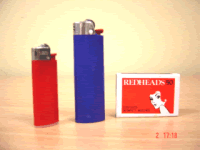Matches: safety matches or cigarette lighters
.png)
 |
 |
 |
||
 |
 |
|||
Safety matches and lighters:
Passengers may carry on their person one (1) small packet of safety matches or one (1) small cigarette lighter that does not contain unabsorbed liquid fuel, other than liquefied gas. Matches and lighters are not permitted in checked or carry on baggage. Lighter fuel and lighter refills are totally forbidden. See Section 2.3.5.5 and 2.3.5.8.4 (e) of the current IATA DGR for expanded details.
Note:
i) “Strike anywhere” matches are matches that require minimal friction to ignite. These include “book type” matches that are commonly found in hotels and restaurants. These are totally forbidden.
ii) "Blue flame" or "Cigar" lighters are not permitted on one's person, carry-on or checked baggage. These are totally forbidden.
iii) Cigarette lighters should have two independent actions by the user to activate ignition.
iv) Cigarette lighters powered by a lithium ion or lithium metal battery without a safety cap or means of protection against unintentiional activation are not permitted on one's person, carry-on or checked baggage.
v) Cigarette lighters powered by a lithium batteries may be carried on one's person if they have a safety cap or some means of protections against unintentional activation. It is not permitted to recharge these devices or their batteries on board the aircraft. Measures must be taken to prevent accidental activation.
Please note the following from the table above:
You will notice in the above table that safety matches and small lighters can only travel 'on one's person'. This simply means you can carry them in the pockets of your clothing only. They cannot ever be carried in carry-on baggage or checked baggage.
| - |
Permitted in or as carry-on-baggage |
ON ONE'S PERSON
|
|
| - |
Permitted in or as checked baggage |
ON ONE'S PERSON
|
|
| - |
The approval of the operator(s) is required |
NO
|
|
| - |
The pilot-in-command must be informed of the location |
NO
|
Airline / Operator Variations and Differences
QF-02 Division 4.1 Flammable Solids. Passengers and crew are not permitted to bring book matches onto aircraft for personal use. Book matches are only allowed as correctly packed and declared dangerous goods consignments. See Section 2.3.5.5 of the IATA DGR for further reference.

